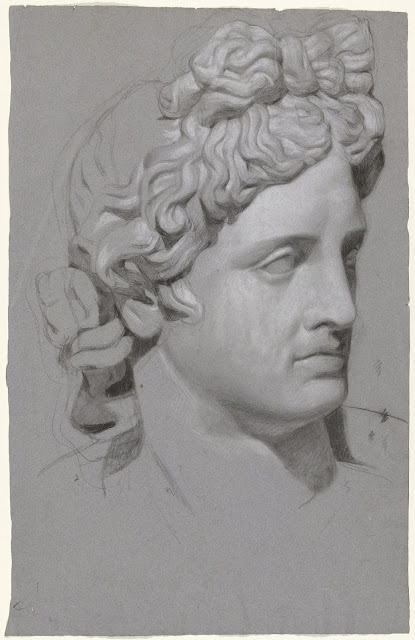 |
| Jean-Baptiste-François Desoria Portrait of Constance Pipelet 1797 oil on canvas Art Institute of Chicago |
 |
| Anonymous French Artist Bust of a Man ca. 1790-1810 drawing Art Institute of Chicago |
 |
| Anonymous Artist Head of Apollo 18th century drawing Rijksmuseum, Amsterdam |
 |
| Maria Christina Campana Antique Head of the Empress Sabina ca. 1776 drawing Minneapolis Institute of Art |
 |
| Antonio Canova Bust of Paris 1809 marble Art Institute of Chicago |
 |
| John Flaxman Amphion and Zethus delivering their mother Antiope from the fury of Dirce and Lycus 1789 drawing Art Institute of Chicago |
NEOCLASSICISM – Term used first in the 16th century for literature that pointedly adopted classical forms and themes, and later given to decorative and architectural styles that opposed the rich complexities and suave appeals of the Baroque and Rococo in the 18th. It was associated with better archaeological knowledge of antiquity through the rediscovery of sites including Herculaneum and Pompeii, but also with discipline and coldness, entering art and design as a mode of 'noble simplicity' – the phrase used by Winckelmann for the essential virtues of Greek sculpture. But self-limitation implies passion, and it is clear that the best Neoclassical art – J.-L. David's earlier paintings, Canova's sculpture and Flaxman's drawings – is inventive as well as being based on ancient models. It embodies emotional elements excluded from the work of more imitative and routine Neoclassicists. Thus Neoclassicism became associated with academies, just as Romanticism implied a revolt against controls, yet it is useful to see Neoclassicism as part of the broad wave of Romanticism, both representing an urge to poeticize and sublimate the world and find heroic formulations for experience and history.
– The Yale Dictionary of Art and Artists by Erika Langmuir and Norbert Lynton (Yale University Press, 2000)
 |
| John Flaxman Achilles and Patroclus (illustration for Pope's Iliad) ca. 1790-93 drawing Art Institute of Chicago |
 |
| John Flaxman Group of Figures ca. 1817 drawing Art Institute of Chicago |
 |
| Anne-Louis Girodet Hermione rejecting Orestes ca. 1799 drawing Art Institute of Chicago |
 |
| Anne-Louis Girodet Phèdre attempting to kill herself with the sword of Hippolytus (illustration for Racine's Phèdre) ca. 1801 drawing (mock-up of printed book page) Art Institute of Chicago |
 |
| Girodet-Anne-Louis- Fingal mourning over the body of Malvina (illustration for Ossian's Berrathon) ca. 1810 drawing Art Institute of Chicago |
 |
| Anton Raphael Mengs Study of an Antique Bust of a Woman before 1779 drawing Rijksmuseum, Amsterdam |
 |
| Leandro Ricci Bas-Relief with Triumph of Bacchus and Ariadne late 18th century drawing Art Institute of Chicago |
 |
| James 'Athenian' Stuart Study of a Temple ca. 1751-88 drawing British Museum |